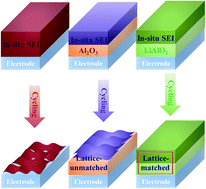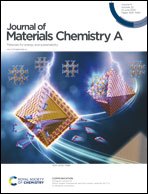A lattice-matched interface between in situ/artificial SEIs inhibiting SEI decomposition for enhanced lithium storage†
Abstract
Due to the continuous decomposition of the in situ solid-electrolyte interphase (SEI) between the electrolyte and anodes such as Li metal, Si, MoS2, etc., the low cycling stability has become one of the challenges for practical application of new-type Li-ion batteries (LIBs) with high energy density. Herein, an artificial LiAlO2 SEI is inserted between the in situ SEI and anode to improve the cycling stability of the batteries, through the formation of lattice-matched interfaces between the artificial LiAlO2 and in situ formed SEI components such as LiF, Li2CO3, LiPO2F2, etc. The lattice-matched interfaces can efficiently suppress mechanical and chemical degradation and retain the in situ SEI and consequently the cell stability through cycling. Taking a conversion-type Ni3S2 electrode as a model system, the stabilization mechanism of the in situ SEI is well illustrated and the reversible capacity attenuation of Ni3S2 from the 2nd to 100th cycle can be significantly reduced from 35.8% to 1.2%, in the presence of the lattice-matched interfaces. The proposed strategy is highly effective and inspiring to solve the challenge of in situ SEI decomposition and achieve a stable cycling in LIBs with different electrodes.



 Please wait while we load your content...
Please wait while we load your content...